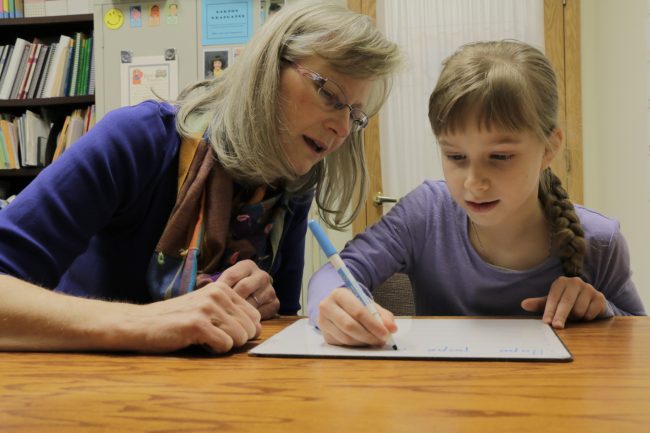Is your child struggling to read? Do you suspect that your child might be dyslexic because he/she is a reluctant reader? Are you wondering what you can do to support them?
There are as many ways to learn to read and write as there are children. So it’s a fine line between not worrying too much that your child is taking time to read (many children aren’t fluent until the ages of 7 or 8 but they catch up) and finding out if your child might have a learning disability like dyslexia as soon as possible by testing them so he or she can get the help needed.
In fact, research shows that it seems to be the children who are only slightly hampered that fall through the cracks. They manage well enough but never do as well as they could. They could just be slow on the reading spectrum or their dyslexia might not even be suspected or tested. The school system does not have the funds to help them and they find it difficult to realise their potential.
 If your child is a reluctant reader or dyslexic then there are a number of things that you can do to help. It might be difficult to get the help inside of the school system, though. The school curriculum is quite rigid and children who don’t keep up often fall behind. Since most subjects in school rely on reading and writing, it is vital that children are given the help they need to be as confident and stress-free about language as possible.
If your child is a reluctant reader or dyslexic then there are a number of things that you can do to help. It might be difficult to get the help inside of the school system, though. The school curriculum is quite rigid and children who don’t keep up often fall behind. Since most subjects in school rely on reading and writing, it is vital that children are given the help they need to be as confident and stress-free about language as possible.
One of the best things you can do is give your child tutoring, until they are comfortable enough to tackle their studies themselves. Getting a tutor who is an expert in dyslexia is even better, as they will know several ways in which such children can be helped. Tutors can also help your child organise himself better, as soft-skills and self-discipline are often things that such children struggle with. This makes studying for tests in a time-tabled way and handing in assignments on time challenging.
Remember not to over-push dyslexic children, as too much reading practice can be counterproductive, and cause them to hate reading more than ever. The phrase ‘my brain is tired’ is actually the truth in a way, as dyslexics produce much more lactic acid in the brain than normal while reading. Build-up of lactic acid is what causes fatigue in your muscles, so it is true that the effort of exercising their brains while reading actually tires them.
Another thing you can do is subscribe to a reading programme designed for dyslexics, which allow sensory reading and writing, like on sandpaper or sand. Dyslexics learn with their senses as well, so sight words and other kinds of visual aids will help.
Children with learning disabilities sometimes find masses of printed words too distracting. It helps to break things down line by line for them, especially when it comes to things like giving instructions or finding answers. I once had very good results with a dyslexic boy by cutting out a hole in a piece of cardboard, like a window, that he slid along the page. By reading word by word he was able to pay attention and not get overwhelmed by all the print on the page.
Using different coloured backgrounds, such as coloured paper, is also very useful sometimes. It helps reduce the ‘visual stress’ children experience. According to research in the UK by Professor Arnold Wilkins, about 20% of all children tested had some form of discomfort with reading that was made better by using colour to bring out or reduce contrast and help with language processing in the brain.
Classrooms are busy places and children often do not get the time or tools they need, even if they have access to special needs. Writing by hand, copying from the board etc. all incredibly stressful for kids with dyslexia or dysgraphia. Some children might also have fine motor skill issues that make their handwriting very bad, which is infuriating to hear for the student considering how much effort it took for them to write! Spelling is, of course, a real challenge as well.
 Using a computer with a spell-checker is a great tool for such students. Children with a certified learning difference (I like that word much better than disability!) should be allowed a laptop for sure. Talk to your school principal to see if this can be allowed at least part of the time, if you child still has some sort of unidentified difficulty. Computers also allow for different coloured backgrounds so this helps in many ways.
Using a computer with a spell-checker is a great tool for such students. Children with a certified learning difference (I like that word much better than disability!) should be allowed a laptop for sure. Talk to your school principal to see if this can be allowed at least part of the time, if you child still has some sort of unidentified difficulty. Computers also allow for different coloured backgrounds so this helps in many ways.
However, the most important way in which you can help your dyslexic or reluctant reader is child is by reading with and to him/her. Allow them to choose books that they want to read and don’t worry about how easy or hard the book might be. Self-choosing books based on interest is one of the best ways of encouraging reading.
There are also several associations and websites you can go to, that can give parents and children a great deal of help. You can join a support or chat group, or even start one! Above all, don’t despair. Several famous people, even authors who write tonnes of dialogue and actors who have to read and memorise them, have had some form of learning challenges, such as Tom Cruise, Richard Branson, W.B. Yeats and F. Scott Fitzgerald. Even in the past, when things like dyslexia were unheard of, this didn’t stop them from functioning well beyond the average, and your child can too!
Elisa x
